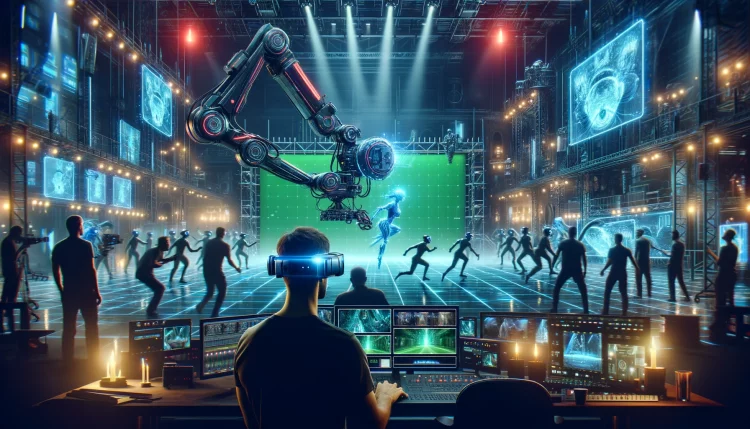The Japanese film industry, known for its innovation, is once again on the cusp of a major transformation. Technology is rapidly reshaping how films are made, distributed, and experienced. From cutting-edge CGI to virtual reality (VR), advancements are opening new doors for creativity and storytelling. This article explores how technology is revolutionizing the future of Japanese cinema and influencing filmmakers across the globe.
1. CGI and Visual Effects: Expanding Creative Possibilities
In recent years, computer-generated imagery (CGI) has been a game-changer in Japanese cinema, especially in genres like anime, fantasy, and sci-fi. Films like Shin Godzilla (2016) and Weathering with You (2019) have demonstrated the potential of CGI to create visually stunning, immersive worlds.
- Impact: CGI allows filmmakers to push the boundaries of their imagination, blending realism with fantasy in ways that were previously impossible. This technology is particularly transformative for Japanese anime, allowing more dynamic and intricate visual effects that elevate storytelling.
2. Virtual Reality and Immersive Storytelling
Virtual reality (VR) is one of the most exciting developments in cinema, offering audiences an immersive experience like never before. Japanese filmmakers are experimenting with VR to create interactive films, where viewers can explore scenes and characters in a 360-degree environment.
- Impact: VR technology offers a completely new way of engaging with films, making the audience an active participant in the storytelling process. Directors are finding new ways to adapt traditional narratives to fit this immersive format, reshaping the very definition of cinema.

3. AI in Filmmaking: Automation and Creativity
The use of artificial intelligence (AI) is becoming increasingly common in the Japanese film industry, from scriptwriting assistance to post-production. AI can automate various processes like editing, CGI rendering, and even dialogue synchronization in dubbed films. It also aids in analyzing trends and audience preferences, helping producers make informed decisions.
- Impact: AI enhances the efficiency of the filmmaking process while still allowing room for human creativity. Filmmakers can now spend more time focusing on artistic choices rather than getting bogged down by technical details.
4. Streaming Platforms and Global Accessibility
With the rise of streaming platforms like Netflix, Amazon Prime, and Japanese services like U-NEXT, the distribution model for Japanese films has radically changed. These platforms provide instant access to Japanese films for global audiences, making them more accessible than ever before.
- Impact: Streaming services are democratizing film distribution, giving indie filmmakers and smaller studios a chance to showcase their work on a global stage. Japanese cinema, particularly anime, has seen a surge in international popularity thanks to these platforms.
5. 3D Animation: The Future of Anime
While hand-drawn animation has long been a staple of Japanese anime, the industry is increasingly adopting 3D animation technologies. Films like Doraemon: Stand by Me and Dragon Quest: Your Story showcase the impressive possibilities of 3D rendering in anime, combining the traditional emotional storytelling with hyper-realistic visuals.
- Impact: The rise of 3D animation in Japan is creating new opportunities for anime studios, blending the charm of traditional anime with cutting-edge technology. This evolution is likely to define the future of anime films, appealing to both domestic and international audiences.
6. AI-Powered Subtitles and Dubbing
Language barriers have long limited the international reach of Japanese cinema, but AI-powered subtitles and voice dubbing technology are rapidly closing that gap. By using AI to generate more accurate subtitles and high-quality dubbing, Japanese films are becoming more accessible to global audiences.
- Impact: The adoption of AI in localization not only speeds up the process but also improves accuracy and nuance in translation. This is crucial in maintaining the original tone and emotional weight of Japanese films for international viewers.
7. Drone Filming: Redefining Cinematic Angles
Drone technology is transforming cinematography by allowing filmmakers to capture scenes from dynamic aerial angles at a fraction of the cost of traditional methods. From action-packed sequences to serene landscapes, drones offer filmmakers a new level of versatility in storytelling.
- Impact: Drones have made it easier to shoot intricate, large-scale scenes that were once impossible to capture without a massive budget. For Japanese filmmakers, especially in genres like historical dramas and nature films, drones provide the tools to craft more visually stunning narratives.
8. Blockchain and Decentralized Film Distribution
The integration of blockchain technology into the film industry is also gaining traction in Japan. Blockchain offers a decentralized platform for filmmakers to distribute their content directly to viewers, bypassing traditional film distribution networks.
- Impact: This technology provides more control to creators, allowing independent filmmakers to monetize their work while maintaining artistic integrity. Blockchain can also be used to track intellectual property rights, reducing piracy and ensuring fair compensation.
9. Augmented Reality (AR) in Cinema
While virtual reality immerses the viewer in a film, augmented reality (AR) adds digital elements to the physical environment. In Japan, AR is being experimented with in film screenings, offering viewers an interactive experience where characters or objects from the film can “appear” in the theater.
- Impact: AR technology adds a new layer to movie-going, creating a more interactive and engaging cinematic experience. This innovation could redefine how audiences interact with films, particularly in genres like anime and fantasy.
Conclusion
The fusion of technology and cinema is revolutionizing the Japanese film industry, enabling filmmakers to experiment with new forms of storytelling and reach broader audiences. From AI-driven innovations to immersive VR experiences, the future of Japanese cinema is bright, pushing the boundaries of what is possible in film. As Japan continues to innovate, its influence on global cinema will only grow, further cementing its place as a leader in cinematic art and technology.










